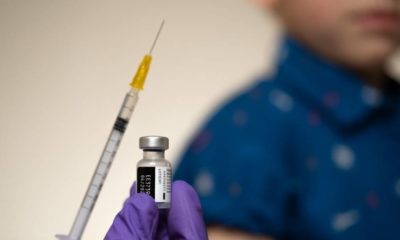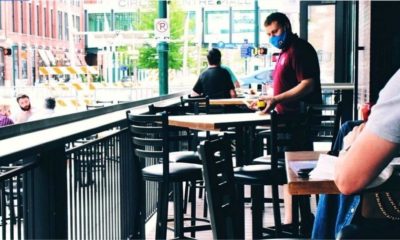Breaking News
Coronavirus Leads to Thousands of Inmates Going Free; Will California Release 10,000?

Cramped, crowded conditions. Prolonged exposure to other people. Limited access to critical health care treatment.
These conditions in state prisons and county jails nationwide have sparked urgent calls for the release of thousands of inmates across the country as corrections officials rush to avoid catastrophic outbreaks of coronavirus inside institutions that could infect inmates, correctional staffers and, ultimately, their families and communities at large.
In Iowa, 700 inmates who had been approved for parole or work release are seeing their releases expedited, according to the Des Moines Register. New Jersey jails are releasing as many as 1,000 inmates, according to the New York Times.
And in California, where at least one inmate and five correctional workers already have tested positive for COVID-19, inmate advocates are saying the state may need to release thousands of inmates to reduce overcrowding that could endanger countless people inside and outside the facilities.
“I do think they should release 10,000,” said Michael Bien, the lead attorney for thousands of mentally ill inmates inside state-run prisons. “We don't want to do anything sloppy, and there's no way this administration is going to do that.
“But they should be looking in terms of (inmates) in hospice care, or who have applied for medical parole, people who have applied for compassionate release and have families or a place to go or benefits in place.”
Governor Vows No Violent Criminals to Win Release
Gov. Gavin Newsom acknowledged Monday that steps may need to be taken toward reducing inmate crowding because of the crisis, but said any decision would be made to ensure public safety.
“I have no interest — I want to make this crystal clear — in releasing violent criminals from our system,” Newsom said. “And I won't use a crisis as an excuse to create another crisis…
“If we start to release prisoners that are not prepared with their parole plans they may end up out on the streets and sidewalks in a homeless shelter. If we don't prepare people to get back on their feet they may end up in the emergency rooms clogging the system that we were trying to address in the first place. We have to be very thoughtful about this.”
Newsom added that he realizes inmate advocates are saying, “Let's just let out tens of thousands of prisoners.”
“That's not the way we're going to go about this,” he said. “It will be for those non-violent offenses, and we're going to do it in a systemic way.”
Coronavirus leads to thousands of inmates going free; will California release 10,000? https://t.co/UJ5nFk1SqZ
— MercedSunStar (@MercedSunStar) March 24, 2020
Coronavirus Task Force Meeting Amid Emergency
U.S. District Judge Kimberly J. Mueller ordered the creation of a task force last week comprised of state officials and inmate attorneys to report back to her on how best to handle the coronavirus crisis, and advocates for the inmates have launched nationwide campaigns, arguing that reducing prison and jail overcrowding protects guards, staffers and their families.
“This is an emergency, and we're talking about what steps should be taken in an emergency to help the prison officials manage the population safely for the staff and the prisoners,” Bien said.
The American Civil Liberties Union and numerous civil rights groups have suggested a variety of possible measures, including a plea to President Trump on Tuesday to consider commuting sentences for older inmates, chronically ill prisoners and others.
California Prisons Overcrowded for Decades
California's prison system has been overcrowded for decades, with a current population of more than 117,000 inmates, about 131 percent of design capacity. The state has made progress in reducing capacity since the U.S. Supreme Court issued a landmark order in 2011 requiring the state to cut its prison population by 33,000 inmates over a two-year period.
At the time, the prison population was about 180 percent of design capacity.
State prison officials say they have taken steps to protect guards, staffers and inmates from the spread of the disease, including quarantining some inmates, halting transfer of most inmates between facilities and providing protective gear.
Some prison workers say privately they do not believe the California Department of Corrections and Rehabilitation has done enough, telling The Bee they are subjected to cursory questioning about their health and do not regularly have their temperatures taken, as promised. Others note that just entering prisons through secure entrances place them in confined spaces with others.
Who can Safely be Released?
And law enforcement officials say dealing with the debate over releasing inmates because of coronavirus is part of an argument authorities have had for years over who can safely be released.
“It's all very challenging and complex,” Sacramento District Attorney Anne Marie Schubert said. “You have people who have already demonstrated that they cannot follow rules in society. So how can we keep the community safe when they get out and engage in more dangerous behavior, including crimes and risky behavior?
“Clearly, anyone convicted of serious, violent, sex or domestic violence crimes should not be released, in my view.”
California jails already have begun some releases on the county level, with the Sacramento County Jail beginning releases March 17 of some non-violent, non-serious prisoners who had less than 30 days to serve.
Sheriff's Sgt. Tess Deterding said 120 inmates were released last week over a 2 { day period. One inmate released still had 11 days to serve, the longest of any who were let go, she said.
The releases freed up housing units at both the Main Jail downtown and Rio Cosumnes Correctional Center near Elk Grove that can be used if there is an outbreak. So far, no one in either jail has tested positive, she said, and there are no current plans for further releases at this point unless conditions change.
“The sheriff's going to reassess as this thing progresses,” she said.
Sonoma County announced similar plans and other jails were expected to follow suit. In Santa Clara County, one inmate in San Jose has tested positive.
And on Tuesday afternoon, the Los Angeles County Sheriff's Department announced at least 1,700 jail inmates have been recently released from custody there.
Former Sacramento Sheriff John McGinness argued that, unless there is a major outbreak inside prisons, inmates can be treated the way most other people with the disease are.
“If you look at the data, the majority of people who experience coronavirus are recovering at home,” he said. “So with that being the case, probably the inmate population could recover at their home as well.
“That said, if you have an explosion of serious disease and it spreads to the staff it could be a catastrophic event. Knocking some time off (a sentence) probably makes some sense, but it's important to understand we don't have any non-violent offenders in custody anymore.”
___
(c)2020 The Sacramento Bee (Sacramento, Calif.)
Visit The Sacramento Bee (Sacramento, Calif.) at www.sacbee.com
Distributed by Tribune Content Agency, LLC.












